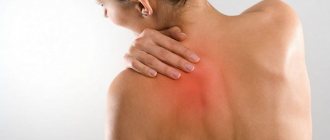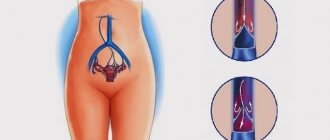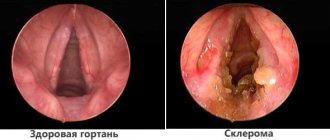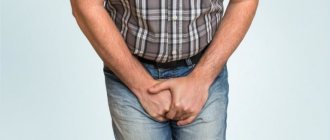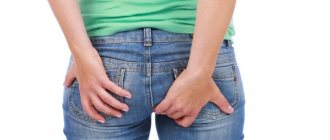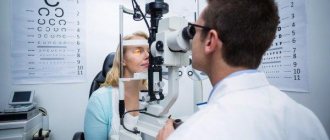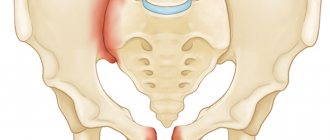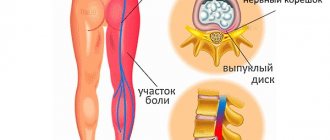Diseases of the musculoskeletal system are a very common phenomenon in modern society. Lack of physical activity, poor diet and concomitant diseases increase the risk of this pathology in patients. Damage to the lower extremities is especially common, since they bear the main burden in everyday life.
When visiting a doctor, many people complain of pain in their legs above the knee. First of all, patients are interested in why these sensations occur and how they can be eliminated.
Sometimes such a symptom can bother you for a long time, disrupting the usual rhythm of life and creating noticeable physical and psychological discomfort. Therefore, an important task at the primary stage of medical care is to find out the causes of the pathology and its accurate diagnosis, so that in the future it is possible to competently plan treatment measures.
Causes
If your legs hurt above the knees, this is the result of various factors. First of all, such a symptom may be associated with changes in the muscles of the thigh and pelvis. However, pain in the legs is a sign not only of local disorders, but also of general pathology. Therefore, it is necessary to study in detail the patient’s risk of developing other diseases that at first glance are not related to the skeletal system.
The appearance of pain in the leg muscles is provoked by the following reasons:
- Injuries (bruises, sprains and tendon ruptures).
- Inflammation in the muscles (myositis), tendons (tendonitis) and fascia (fasciitis).
- Vascular diseases (thrombosis, thrombophlebitis).
- Water and electrolyte disturbances (lack of calcium, potassium, excess sodium).
- Osteoarthritis of the hip and knee joints.
- Systemic connective tissue diseases (scleroderma, dermatomyositis).
- Osteochondrosis of the lumbar spine.
- Fibromyalgia.
- Physical overexertion.
Elimination of the most common risk factors is the basis of primary prevention of pain in the lower extremities. In addition, timely treatment of concomitant diseases helps prevent its development.
Recovery time
With myalgia of the thigh muscles caused by inflammation, stretching, with adequate treatment, improvement occurs very quickly. Acute symptoms subside within a few days, and leg function is restored within 2-3 weeks.
If the cause of hip pain lies in other diseases, then without basic treatment you cannot expect recovery. You need to trust a specialist and undergo the examination prescribed by him, follow all treatment prescriptions.
Victor Systemov – expert of the 1Travmpunkt website
Our legs are often overloaded, so dysfunction is observed in the bone, joint, and muscle tissues of the right and left lower limbs. The person will feel his leg being pulled from the hip to the back of the knee. Sometimes the discomfort can go away on its own; if the nagging pain does not go away, the patient needs to consult a doctor. The doctor will help determine the causes of discomfort and prescribe treatment.
Symptoms
Since pain in the hip and buttocks is the result of various diseases, to determine the cause of its occurrence it is necessary to conduct a competent differential diagnosis. An assessment of symptoms during a medical examination allows us to make a tentative conclusion about the disorders that worry the patient.
Pain is not the last manifestation of pathology, but can often be the only similar symptom in many conditions. Therefore, it is worth paying more attention to considering the characteristics of the most common diseases.
Injuries
The causes of pain above the knee are often injuries to the soft tissues of the hip. This situation occurs when playing sports, at home, or becomes the result of accidents. The mechanism of injury determines the type of injury, and the localization of symptoms depends on which muscles are damaged: in the buttock, anterior, posterior or inner thigh.
With bruises, you can observe the appearance of swelling in the area of injury, abrasions and subcutaneous hematoma. Knee flexion or extension may be limited due to pain in the back or front of the thigh, respectively. Tendon sprains or ruptures are manifested by local painful thickening and the inability to make movements of the limb in which the damaged muscles are involved.
After receiving an injury, you should consult a doctor as soon as possible - the success of treatment will depend on the timeliness of assistance.
Myositis
After a bruise or sprain, the muscles can become inflamed and myositis develops. The inflammatory process in the femoral muscle often occurs due to hypothermia, vascular disorders and pathologies of the spine.
Depending on which muscle is affected, the pain is localized in front or behind the knee. The motor activity of the limb decreases, swelling and redness may appear. The pain syndrome resembles aching in the bones, as with a cold. The general condition worsens, sometimes the body temperature rises.
For myositis, both symptomatic treatment aimed at relieving inflammation and specific therapy to correct the underlying disease are prescribed. If the cause of inflammation is injury, then only anti-inflammatory drugs, physiotherapy and exercise therapy are used.
Inflammatory diseases
Inflammation of muscle or connective tissue leads to the formation of myositis, tendinitis and fasciitis. The causes of these changes can be either local damage due to injury or overexertion, or general infections (for example, influenza).
Myositis is characterized by severe pain in the leg, which intensifies not only with contraction of the affected muscle, but also at rest or at night. The following signs are typical:
- Compaction of tissues in the form of a cord or roller.
- Redness of the skin.
- Increase in local temperature.
- Pain on palpation.
- Muscle weakness.
Tendinitis is accompanied by similar symptoms, with a characteristic crunching sound during movements involving the affected tendon. Inflammation of the fascia occurs with changes in the skin - it becomes rougher and takes on the appearance of an “orange peel”. Fasciitis can occur as a local infectious process, which is caused by the introduction of microbes from the outside. This situation is often observed in the buttock area.
Causes of pain in the muscles of the inner thigh
The medial (internal) muscle group of the thigh includes: 3 adductor muscles – long, short and large, gracilis and pectineus muscles. All of them are attached to the femur and pelvis and perform the function of bringing the hip, that is, into a straight position along the axis of the body. Pain in the leg on the inner side of the thigh can occur both due to muscle pathology itself, most often when they are overstretched in athletes, and due to problems in the groin and pelvic area.
Adductor
Most often, pain occurs in the adductor magnus muscle, which carries out the greatest load. Pain when stretched in the thigh during intense training and excessive abduction of the leg to the side can appear due to stretching or tears of muscle fibers. General innervation (supply of organs and tissues with nerves) with the pelvic organs can cause pain of a secondary nature due to pathology in the area:
- Bladder;
- Uterus;
- Prostate;
- For hernias of the obturator foramen of the pelvis.
Fine
The gracilis muscle is the longest of the adductor group. It runs along the inner surface from the pubic bone to the fascia of the leg, woven into it at the level of the tibia. In addition to adducting the thigh, the muscle is involved in flexing the leg at the knee joint and rotating it inward.
The pain is localized along the entire inner surface of the thigh to the lower leg. Secondary pain can also occur with pathology of the pelvic organs, damage and divergence of the pubic symphysis (joint), for example, during difficult childbirth, when the fetus is large. The muscle is attached at the symphysis itself.
Vascular pathology
If your legs hurt above the knees, this may be a manifestation of vascular diseases. This symptom is especially characteristic of venous thrombosis and thrombophlebitis, when the outflow of blood is disrupted due to the accumulation of fibrin clots. The following signs are characteristic:
- Constant throbbing and burning pain in the muscles.
- Severe swelling of the leg.
- The skin is dense, pink-bluish in color, warm to the touch.
- Upon palpation, painful compactions in the form of cords can be identified.
If thrombophlebitis becomes chronic, there is a risk of a blood clot rupturing, which can cause myocardial infarction, stroke, or pulmonary embolism. These are conditions that require emergency treatment as they can be fatal.
Vascular diseases of the legs are a dangerous pathology, so if you suspect such a condition, you should immediately consult a doctor. Timely and adequate treatment will protect against adverse events.
Osteoarthritis
When the hip joints hurt due to osteoarthritis, the sensation may spread to the buttock, groin area, and if the knee is affected, to the front surface of the thigh. In severe cases of the disease, pathological changes are also observed in the periarticular muscles, which are inflammatory-dystrophic in nature.
Osteoarthritis is mainly characterized by the following manifestations:
- “Starting” pain (appears at the beginning of the load), which later becomes constant.
- Crunching and friction in the joints.
- Deformities in the knee area.
- Impaired walking (especially if the hip joint is affected).
- Pain on palpation of the periarticular area.
Osteoarthritis of the hip joints becomes a real problem for many patients, as it significantly limits their motor activity, even to the point of disability.
Types of pain in the hip
The nature of the pain can be different:
- Nagging pain is more often associated with pathology of the hip joint, spine, and pathology of the femur;
- Shooting pains or “lumbago” appear when the nerve roots leading to the thigh are pinched in the spine;
- Burning pain. A burning sensation in the thigh muscles is a common symptom of inflammation of the thigh nerves;
- Pain of a spastic nature , when the thigh muscles contract with severe pain. The causes of thigh muscle spasms can be diseases of the nervous system and blood vessels, metabolic disorders;
- Painful spontaneous twitching can be a symptom of impaired water-electrolyte metabolism, neuritis, during stressful situations or after physical overexertion.
Often, severe pain in the left or right thigh, radiating to the leg when walking and moving, is of a mixed nature, and only a doctor can understand their cause.
Diagnostics
The question of why the patient’s legs hurt in the hip area can be finally resolved only on the basis of additional examination methods. In some cases, a routine clinical examination is not enough. Therefore, to make a final diagnosis, various laboratory and instrumental tools are used:
- Biochemical blood test (electrolytes, coagulogram, rheumatic tests).
- Magnetic resonance imaging.
- Ultrasound with Dopplerography.
- Radiography.
- Angiography.
Magnetic resonance imaging and ultrasound are most suitable for examining soft tissues. Vascular pathology requires Dopplerography and angiography. If fractures or joint diseases are suspected, an x-ray is recommended.
Treatment
For pain in the legs from the knees to the buttock, it is necessary to treat the underlying disease that caused them, using etiotropic and pathogenetic agents. However, we must not forget about symptomatic therapy, which will reduce the manifestations of the disease. Thus, such a condition must be treated comprehensively, making corrections in accordance with the individual characteristics of the patients.
The following methods are mainly used:
- Drug treatment.
- Physiotherapy.
- Exercise therapy and massage.
- Operation.
The formation of treatment tactics is determined by the type of pathology and the corresponding standards of medical care.
Medications
The use of medications accompanies the treatment of any disease. You can use injection, tablet forms or topical products (ointment, gel, cream). For muscle pain in the thigh area, the following remedies are used:
- Painkillers.
- Anti-inflammatory.
- Muscle relaxants.
- Decongestants.
- Vitamins and minerals.
The development of the infectious process requires the use of antibiotics, in case of vascular pathology - anticoagulants and antiplatelet agents (to reduce blood clotting), in the case of systemic connective tissue diseases - cytostatics and hormones, and in osteoarthritis - chondroprotectors.
Physiotherapy
Physiotherapeutic techniques can expand the possibilities of treating injuries, osteoarthritis, osteochondrosis and other pathologies of the musculoskeletal system. In this case, the procedures can be performed even during exacerbation of the disease, but we must not forget about contraindications to their use. Most often, the treatment complex includes:
- Electro- and phonophoresis of drugs.
- Magnetotherapy.
- UHF and laser therapy.
- Paraffin and mud therapy.
Exercise therapy and massage
In case of lesions of the musculoskeletal system, an important place in therapeutic and rehabilitation measures is given to physical therapy and massage. Treatment of injuries, osteoarthritis and osteochondrosis is not complete without gymnastic exercises. They must be performed as early as possible to stop the progression of the pathology and prevent complications. Performing a massage is useful for inflammatory diseases of soft tissues, osteochondrosis, fibromyalgia and other diseases.
In case of vascular pathology, it is necessary to ensure rest of the affected limb - excessive movements or rough massage can provoke a blood clot.
Surgery
The operation is indicated for severe injuries, vascular diseases, severe osteoarthritis or osteochondrosis. Mostly minimally invasive techniques are used - intravascular and arthroscopic - they allow you to quickly and effectively perform the intervention with minimal tissue trauma. If it is necessary to suture damaged structures, reposition fractures or replace hip joints, open access is used.
If the muscles of the lower extremities hurt, it is necessary to consult a doctor in a timely manner, since the possibility of effective treatment and prevention of dangerous complications depends on this.
ALL MUSCLES HURT (Muscle pain. Doctor's explanations about muscle pain and disease)
